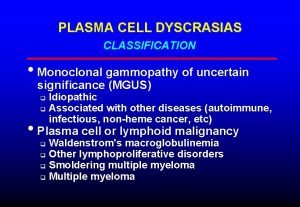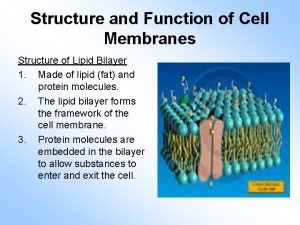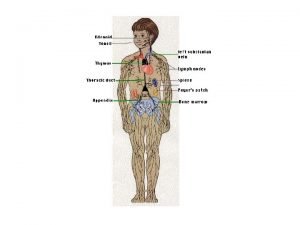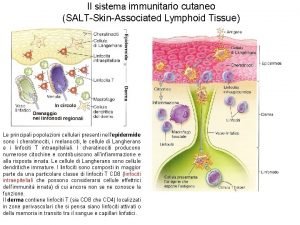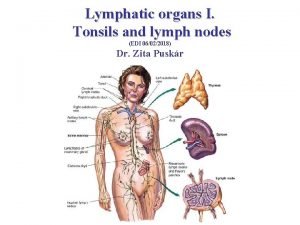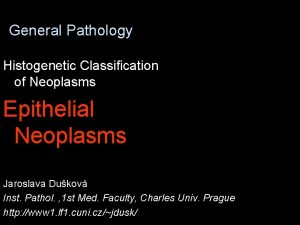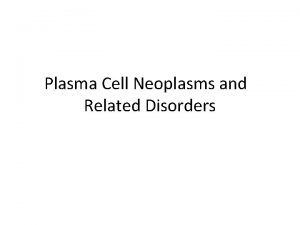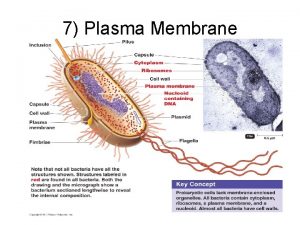Chapter 20 Lymphoid and Plasma Cell Neoplasms Copyright
































































- Slides: 64

Chapter 20 Lymphoid and Plasma Cell Neoplasms Copyright © 2012 Wolters Kluwer Health | Lippincott Williams & Wilkins

Mature B-Cell Neoplasms The WHO Classification of Tumours of the Haematopoietic and Lymphoid Tissues, fourth edition, has enhanced the classification of lymphoid neoplasms by including immunophenotypic features and genetic abnormalities to define different disorders. Copyright © 2012 Wolters Kluwer Health | Lippincott Williams & Wilkins

Mature B-Cell Neoplasms (cont. ) Copyright © 2012 Wolters Kluwer Health | Lippincott Williams & Wilkins

Chronic Leukemias • Chronic leukemias are generally characterized by the presence of leukocytosis with an increased number of mature lymphocytes, lymphocytosis, on a peripheral blood film. • Malignant lymphoproliferative disorders are characterized by an accumulation of lymphocytes. • Both CLL and SLL are neoplasms composed of small B lymphocytes in the peripheral blood, bone marrow, spleen, and lymph nodes, mixed with prolymphocytes and paraimmunoblasts forming proliferation centers in tissue infiltrates. • In contrast to CLL, SLL is used for nonleukemic patients with the tissue morphology and immunophenotype of CLL. Copyright © 2012 Wolters Kluwer Health | Lippincott Williams & Wilkins

Chronic Leukemias: Epidemiology • CLL is the most common form of leukemia in adults in Western countries, but it is very rare in far Eastern countries. CLL/SLL accounts for almost 7% of non-Hodgkin lymphomas (NHLs) in biopsies. • The median age of onset is 65 years. This form of leukemia is rare before age 20 and uncommon before age 50. • More males than females (1. 5 to 2. 1: 1) are afflicted by the disorder. • CLL has the highest genetic predisposition of all hematologic neoplasms. A family predisposition can be documented in 5% to 10% of patients with CLL. The overall risk is two to seven times greater in first-degree relatives of CLL patients. Copyright © 2012 Wolters Kluwer Health | Lippincott Williams & Wilkins

Chronic Leukemias: Etiology • Classic CLL is usually a B-cell disorder. Mature B-cell neoplasms are clonal proliferations of B cells at various stages of differentiation ranging from naïve B cells to mature plasma cells. Mature B-cell neoplasms comprise more than 90% of lymphoid neoplasms worldwide. Copyright © 2012 Wolters Kluwer Health | Lippincott Williams & Wilkins

Chronic Leukemias: Etiology (cont. ) • B-CLL is a biologically and clinically heterogeneous hematologic malignancy characterized by a gradually progressive accumulation of morphologically mature B lymphocytes in the blood, bone marrow, and lymphatic tissues. Cells are characterized as CD 5+, CD 19+, and CD 23+ monoclonal B cells. Copyright © 2012 Wolters Kluwer Health | Lippincott Williams & Wilkins

Mature B-Cell Neoplasms Copyright © 2012 Wolters Kluwer Health | Lippincott Williams & Wilkins

Chronic Leukemias: Etiology • An excess of B cells is more likely to be a result of decreased apoptosis and deregulation of cell cycle control than of an increased proliferation rate. • CLL cells are very resistant to apoptosis. The antiapoptotic BCL 2 gene is reported to be overexpressed in 65% to 70% of B-cell CLLs. Copyright © 2012 Wolters Kluwer Health | Lippincott Williams & Wilkins

Cytogenetics • CLL is heterogeneous at the clinical, cellular, and molecular levels. • Chromosomal alterations occur in approximately 80% of CLL cases; these alterations include the 13 q deletion, the 11 q deletion, trisomy of chromosome 12, and the 17 p deletion. • The high rate of recurrence of the same chromosomal abnormalities suggests that these abnormalities may affect a common pathway. Copyright © 2012 Wolters Kluwer Health | Lippincott Williams & Wilkins

Cytogenetics (cont. ) • Molecular genetics has two major applications in the analysis of chronic lymphoid malignancies: – Demonstration of the clonal nature of a population of lymphoid cells – Detection of pathogenetically important rearrangements, for example, clonal IG or TCR gene rearrangements, that are useful in diagnosis of CLL Copyright © 2012 Wolters Kluwer Health | Lippincott Williams & Wilkins

Cytogenetics (cont. ) • Molecular genetic detection of genomic rearrangements may not only assist with the diagnosis but can also provide important prognostic information. Many of these rearrangements can act as molecular markers for the detection of low levels of residual disease. Copyright © 2012 Wolters Kluwer Health | Lippincott Williams & Wilkins

Molecular Genetics • Variable region genes. The biology of CLL has demonstrated that approximately 50% to 70% of CLL cases undergo immunoglobulin variable region genes (Ig. VH) hypermutation. The Ig. VH mutational status is important in determining the prognosis of patients with CLL. • Zeta-chain, associated protein 70. Another signaling associated molecule, the zeta-chain, associated protein 70 (ZAP-70), was recently discovered to be differentially expressed in the CLL subgroup without Ig. VH mutation that had poor outcomes. • Thymidine kinase. Another new finding is the correlation of the serum value of thymidine kinase with Ig. VH gene mutational status and also with disease progression. DNA microarray has demonstrated that CLL exhibits a characteristic gene expression profile closely related to memory B cells and independent of the presence of Ig. VH mutations. Copyright © 2012 Wolters Kluwer Health | Lippincott Williams & Wilkins

Molecular Genetics (cont. ) • CD 38. Expression of CD 38, a membrane protein that marks cellular activation and maturation and that has signaling activity, often correlates with the presence of Ig. VH mutations. CD 38 surface expression on the malignant cell is now viewed as an independent marker of a patient’s clinical outcome. Copyright © 2012 Wolters Kluwer Health | Lippincott Williams & Wilkins

Molecular Genetics (cont. ) • Micro. RNA (mi. RNA) expression profiles can be used to distinguish normal B cells from malignant B cells in CLL patients. Micro. RNAs regulate the expression of protein-coding genes and can act as oncogenes, tumor suppressors, or both. Alterations in CLL affect the following: – Evasion of apoptosis – Self-sufficiency in growth – Stimulation of angiogenesis and dissemination Copyright © 2012 Wolters Kluwer Health | Lippincott Williams & Wilkins

Evasion of Apoptosis • Evasion of apoptosis is associated with overexpression of the antiapoptotic protein BCL 2 is responsible for maintaining the delicate homeostasis between proliferation and apoptosis and promotes cell survival by inhibiting cell death. • Self-sufficiency in growth demonstrates that normal cells require growth stimuli compared to cancer cells that are capable of generating their own growth signals without having to rely on mitogens in the surrounding environment in order to actively proliferate. Copyright © 2012 Wolters Kluwer Health | Lippincott Williams & Wilkins

Staging and Prognosis • The staging classification is as follows: − 0—Bone marrow and blood lymphocytosis − I—Lymphocytosis with enlarged nodes − II—Lymphocytosis with enlarged spleen or liver or both − III—Lymphocytosis with anemia − IV—Lymphocytosis with thrombocytopenia Copyright © 2012 Wolters Kluwer Health | Lippincott Williams & Wilkins

Prognosis • Since the introduction of clinical stages, there has been a continuous effort to identify new prognostic factors in CLL. Parameters with demonstrated independent prognostic value include the following: – Number of lymphocytes in the peripheral blood – Degree of bone marrow infiltration – Proportion of abnormal lymphoid cells in the peripheral blood – Lymphocyte doubling time – Immunoglobulin heavy-chain variable-region gene mutation status – Cytogenetic abnormalities assessed by fluorescent in situ hybridization – Z-chain–associated protein kinase-70 protein expression Copyright © 2012 Wolters Kluwer Health | Lippincott Williams & Wilkins

Clinical Signs and Symptoms • The typical patient with CLL is asymptomatic, and the disease is usually discovered at the time of a routine physical examination. • The disease is typically suggested by abnormal findings discovered on a complete blood count (CBC) for the evaluation of an unrelated illness. Copyright © 2012 Wolters Kluwer Health | Lippincott Williams & Wilkins

Laboratory Data • Normal bone marrow elements get crowded out because of the excessive lymphoid production and packing of the marrow space by malignant lymphocytes. This infiltration by the leukemic clone results in anemia, thrombocytopenia, and neutropenia. • Although leukocytosis may be observed, it is less pronounced than in chronic myelogenous leukemia. Total leukocyte counts can range from 30 to 200 x 10 9/L. In one third of patients, the total leukocyte count is greater than 100 x 109/L. Copyright © 2012 Wolters Kluwer Health | Lippincott Williams & Wilkins

Laboratory Data (cont. ) • Peripheral blood smears commonly exhibit up to 80% or 90% small lymphocytes. • Many of these cells have an overmature look because of the hypercondensed nuclear chromatin pattern. • An occasional large lymphoblast may be noted. Smudge cells are highly characteristic. • Both the granulocytes and the platelets are normal. Copyright © 2012 Wolters Kluwer Health | Lippincott Williams & Wilkins

Laboratory Data (cont. ) Figure 20. 1 Chronic lymphocytic leukemia. Mature cells predominate in the chronic leukemias. In this blood smear, a typical increase in the number of smudge cells is seen. (Simulates magnification × 1, 000. ) Copyright © 2012 Wolters Kluwer Health | Lippincott Williams & Wilkins

Laboratory Data (cont. ) Figure 20. 2 Two slides showing chronic lymphocytic leukemia. (Reprinted with permission from Anderson S and Poulsen K. Anderson's Atlas of Hematology, Philadelphia, PA: Lippincott Williams & Wilkins, 2003. ) Copyright © 2012 Wolters Kluwer Health | Lippincott Williams & Wilkins

Laboratory Data (cont. ) Figure 20. 3 A: Hyperleukocytosis (left). An elevated leukocyte concentration in a centrigued peripheral blood specimen from a patient with T-cell acute lymphoblastic leukemia (right). Pulmonary alveolar capillaries expanded by leukocyte aggregates indicative of leukostasis in a patient with acute myeloid leukemia. B: Microarray analysis in chronic lymphocytic leukemia (CLL) (left). The expression of C 247 signature genes (right). Differentiation of CLL patients into those with or without mutations of the Ig. V gene by the expresisons of 56 genes and Ig immunoglobulins. (Reprinted with permission from Greer JP, et al. Wintrobe's Clinical Hematology, 11 th ed, Philadelphia, PA: Lippincott Williams & Wilkins, 2004. ) Copyright © 2012 Wolters Kluwer Health | Lippincott Williams & Wilkins

Treatment Options • Previously, patients with CLL were only treated for palliative reasons, but numerous new treatment options are now available for the treatment of CLL. • Allogeneic hematopoietic stem cell transplantation (allo. HSCT) is the only potentially curative treatment available for patients with B-cell CLL. • Newer treatment chemoimmunotherapy was introduced in 2000. This strategy incorporates the use of monoclonal antibodies to chemotherapy. This strategy appears to provide for a first time–observed survival benefit but is not considered curative. Copyright © 2012 Wolters Kluwer Health | Lippincott Williams & Wilkins

Minimal Residual Disease • PCR-based and flow cytometry–based assays are used to assess MRD in CLL. • Real-time PCR has become common for quantification by PCR. Copyright © 2012 Wolters Kluwer Health | Lippincott Williams & Wilkins

Hairy Cell Leukemia • HCL is an uncommon chronic lymphoproliferative disorder of the B-lymphocyte type. This mature B-cell malignancy is diagnosed based on clinical features, morphology, and phenotyping and is generally treated with curative intent. • HCL is much more common in males than in females. It has been suggested that a locus on the X chromosome might be involved in HCL. • It usually affects patients older than 30 years of age. Copyright © 2012 Wolters Kluwer Health | Lippincott Williams & Wilkins

Hairy Cell Leukemia (cont. ) • HCL is so named because of the appearance of fine, hairlike, irregular cytoplasmic projections that are characteristic of lymphocytes in this disease. Cytoplasmic projections are not always obvious in HCL and in some cases (e. g. , artifactually in other lymphoid neoplasms or reactive cells) are not specific for HCL. Copyright © 2012 Wolters Kluwer Health | Lippincott Williams & Wilkins

Hairy Cell Leukemia (cont. ) Figure 20. 4 Hairy cell leukemia. A: Peripheral blood. B: Bone marrow (H&E stain). C: Spleen (H&E stain). (Reprinted with permission from Handin RI, et al. Blood Principles and Practice of Hematology, 2 nd ed, Philadelphia, PA: Lippincott Williams & Wilkins, 2003. ) Copyright © 2012 Wolters Kluwer Health | Lippincott Williams & Wilkins

Prolymphocytic Leukemia • B-cell prolymphocytic leukemia represents a malignancy of B prolymphocytes affecting blood, bone marrow, and spleen. • Prolymphocytic leukemia is characterized by a large number of small lymphocytes with scant cytoplasm and the immature features of prolymphocytes in the peripheral blood. • The leukocytosis can exceed 100 × 109/L. • Prolymphocytes must exceed 55% of lymphoid cells in the peripheral blood. Copyright © 2012 Wolters Kluwer Health | Lippincott Williams & Wilkins

Plasma Cell Neoplasms • Multiple myeloma • Waldenström primary macroglobulinemia Copyright © 2012 Wolters Kluwer Health | Lippincott Williams & Wilkins

Multiple Myeloma • Multiple myeloma is a malignant bone marrow–based plasma cell neoplasm associated with abnormal protein production. • Plasma cell leukemia is an increased number of plasma cells in the peripheral blood and should be considered a form of multiple myeloma and not a separate entity. • Multiple myeloma accounts for approximately 1% of all types of malignant diseases and about 10% of hematological malignancies. Copyright © 2012 Wolters Kluwer Health | Lippincott Williams & Wilkins

Multiple Myeloma (cont. ) • Laboratory results – Anemia is present at the time of diagnosis in approximately two thirds of patients. – Increased plasma volume caused by monoclonal protein commonly produces hypervolemia. – The leukocyte count can be normal, although about one third of patients have leukopenia. Relative lymphocytosis is usually present. Sometimes, eosinophilia is noted. – In rare cases in the terminal stages, plasmablasts and plasma cells may amount to 50% of the leukocytes in the peripheral blood. Rouleaux formation on peripheral blood smears is common. Copyright © 2012 Wolters Kluwer Health | Lippincott Williams & Wilkins

Multiple Myeloma (cont. ) Figure 20. 6 Various appearances of plasma cells in a smear of normal bone marrow. A prominent pale paranuclear zone and cytoplasmic vacuoles are seen in (A) and (B). The cytoplasm in (C) has a reticular appearance. The other cells in (A) are a nonphagocytic reticular cell and a late polychromatic erythroblast. (Reprinted with permission from Mills SE, Histology for Pathologists, 3 rd ed, Philadelphia, PA: Lippincott Williams & Wilkins, 2007. ) Copyright © 2012 Wolters Kluwer Health | Lippincott Williams & Wilkins

Multiple Myeloma (cont. ) • Bleeding is common. • Platelet abnormalities, impaired aggregation of platelets, and interference with platelet function by the abnormal monoclonal protein contribute to bleeding. • Inhibitors of coagulation factors and thrombocytopenia from marrow infiltration of plasma cells or chemotherapy may also contribute to bleeding. • Some patients have a tendency toward thrombosis, which may be manifested by a shortened coagulation time, increased fibrinogen, and increased factor VIII. Copyright © 2012 Wolters Kluwer Health | Lippincott Williams & Wilkins

Multiple Myeloma (cont. ) • Electrophoresis of serum usually demonstrates the overproduction of Ig. M (19 S) antibodies. • Electrophoresis of the serum or urine reveals tall sharp peaks on the densitometer tracing; a dense localized band is seen in 75% of myeloma cases. • A monoclonal serum protein is detected in 91% of patients. The type of antibody is Ig. G in the majority of patients. Less frequently Ig. A is seen, and rarely Ig. D is demonstrated. Copyright © 2012 Wolters Kluwer Health | Lippincott Williams & Wilkins

Multiple Myeloma (cont. ) Figure 20. 7 Abnormal serum protein electrophoretic patterns contrasted with a normal pattern. Polyclonal hypergammaglobulinemia, characteristic of benign reactive processes; shows a broad-based increase in immunoglobulins, owing to immunoglobulin secretion by a myriad of reactive plasma cells. Monoclonal gammopathy of unknown significance (MGUS) or plasma cell neoplasia shows a narrow peak, or spike, owing to the homogeneity of the immunoglobulin molecules secreted by a single clone of aberrant plasma cells. ALB = albumin. (Reprinted with permission from Rubin R, Strayer DS. Rubin's Pathology: Clinicopathologic Foundations of Medicine, 5 th ed, Philadelphia, PA: Lippincott Williams & Wilkins, 2008. ) Copyright © 2012 Wolters Kluwer Health | Lippincott Williams & Wilkins

Multiple Myeloma (cont. ) Figure 20. 8 Protein electrophoresis in plasma cell disease. Serum or urine is placed at one end of a strip of gel‚ across which an electrical current is applied. Most proteins have a negative charge and migrate toward the positive pole at various speeds according to their molecular weight and charge. The serum on the left shows a narrow band in the gamma globulin region. Serum protein has spilled into urine‚ which demonstrates a matching band. In the scan of patient serum on the right‚ the height of the tracing is proportional to the amount of protein stained in each band. Monoclonal protein appears as a tall‚ narrow (monoclonal) “M-protein. ” (Reprinted with permission from Mc. Connell TH, The Nature of Disease Pathology for the Health Professions, Philadelphia, PA: Lippincott Williams & Wilkins, 2007. ) Copyright © 2012 Wolters Kluwer Health | Lippincott Williams & Wilkins

Multiple Myeloma (cont. ) • Treatment – Multiple myeloma is incurable with conventional chemotherapy. – Thalidomide, lenalidomide, and bortezomib are novel agents that first demonstrated efficacy in treating relapsed and refractory MM, but they are now all being utilized as treatment for newly diagnosed disease. Copyright © 2012 Wolters Kluwer Health | Lippincott Williams & Wilkins

Waldenström Primary Macroglobulinemia • The condition of WM has an age-specific incidence. It is most commonly found in older men; the median age of onset varies between 63 and 68 years of age. Onset is usually insidious. The incidence of WM is higher among whites. • Prognostic factors include the patient’s age, β 2 microglobulin level, monoclonal protein level, hemoglobin concentration, and platelet count. The reported median survival of patients with WM ranges between 5 and 10 years from the time of diagnosis. Copyright © 2012 Wolters Kluwer Health | Lippincott Williams & Wilkins

Waldenström Primary Macroglobulinemia (cont. ) • WM is a B-cell neoplasm characterized by lymphoplasma proliferative disorder with infiltration of the bone marrow and a monoclonal immunoglobulin M (Ig. M) protein. • The most consistent feature of the bone marrow or lymph nodes of WM patients is the presence of pleomorphic Blineage cells at different stages of maturation, such as small lymphocytes, lymphoplasmacytoid cells (abundant basophilic cytoplasm but lymphocyte-like nuclei), and plasma cells. Copyright © 2012 Wolters Kluwer Health | Lippincott Williams & Wilkins

Waldenström Primary Macroglobulinemia (cont. ) Figure 20. 9 Waldenström. Bone marrow aspirate showing malignant cells with lymphoid and plasmacytoid morphology. (Reprinted with permission from Greer JP, et al. Wintrobe’s Clinical Hematology, 11 th ed, Philadelphia, PA: Lippincott Williams & Wilkins, 2004. ) Copyright © 2012 Wolters Kluwer Health | Lippincott Williams & Wilkins

Waldenström Primary Macroglobulinemia (cont. ) • Characteristically, blood samples are described as having hyperviscosity. • Detecting monoclonal gammopathies usually involves serum protein electrophoresis (SPEP) and immunoelectrophoresis (IFE) to test both serum and urine. • Additionally, cryoglobulins can be detected in the patient’s serum. Cryoglobulins are proteins that precipitate or gel when cooled to 0 C and dissolve when heated. In most cases, monoclonal cryoglobulins are Ig. M or Ig. G. Copyright © 2012 Wolters Kluwer Health | Lippincott Williams & Wilkins

Lymphomas Copyright © 2012 Wolters Kluwer Health | Lippincott Williams & Wilkins

Relationship Between Lymphomas and Leukemias • The term lymphoproliferative disorder includes the various forms of leukemias and malignant lymphomas that are of lymphoreticular origin. • The neoplastic cells of leukemia and lymphoma have an intimate relationship. Frequently, the neoplastic cells of these two disorders are identical. Copyright © 2012 Wolters Kluwer Health | Lippincott Williams & Wilkins

Characteristics • The lymphomas are a group of closely related disorders that are characterized by the overproliferation of one or more types of cells of the lymphoid system such as lymphoreticular stem cells, lymphocytes, reticulum cells, and histiocytes. • Malignant lymphoma expresses itself as a disorder of the lymph nodes. Copyright © 2012 Wolters Kluwer Health | Lippincott Williams & Wilkins

Common Lymphoid Neoplasms Copyright © 2012 Wolters Kluwer Health | Lippincott Williams & Wilkins

Immunohistological Features of Selected B -Cell Neoplasms Copyright © 2012 Wolters Kluwer Health | Lippincott Williams & Wilkins

Categories • The major forms of malignant lymphomas are divided into Hodgkin and non-Hodgkin (NHL) types. • The NHLs account for more than two thirds of all lymphomas and more than 75% of the fatalities due to lymphoma. • Rare forms of lymphoma include Burkitt lymphoma and mycosis fungoides, a variant of Sézary syndrome, which demonstrates skin involvement. Copyright © 2012 Wolters Kluwer Health | Lippincott Williams & Wilkins

Pathophysiology • Although the etiology of most lymphomas is unknown, the potential role of a virus in the pathogenesis of lymphomas is strongly suspected. • In humans, the development of B cells in the bone marrow is initiated by the assembly of genes for the variable regions of the heavy and light chains of antibodies in B-cell progenitors, mediated by a process called V(D)J recombination. • In this process, the DNA located between the rearranging gene elements is deleted from the chromosome (or sometimes inverted). Copyright © 2012 Wolters Kluwer Health | Lippincott Williams & Wilkins

Genetic Features of Selected B-Cell Neoplasms Copyright © 2012 Wolters Kluwer Health | Lippincott Williams & Wilkins

Hodgkin Disease • Cytogenetic studies now suggest that Reed-Sternberg cells arise from a single clone, a common B-cell precursor located in a germinal center. • Reed-Sternberg cells are a defining feature of Hodgkin disease, but less than 1% of cells in a sample of Hodgkin disease tissue are Reed-Sternberg cells. Copyright © 2012 Wolters Kluwer Health | Lippincott Williams & Wilkins

Hodgkin Disease (cont. ) Figure 20. 10 Reed-Sternberg cell typical of Hodgkin disease. (Reprinted with permission from Rubin E, Farber JL. Pathology, 3 rd ed, Philadelphia, PA: Lippincott Williams & Wilkins, 1999. ) Copyright © 2012 Wolters Kluwer Health | Lippincott Williams & Wilkins

Hodgkin Disease (cont. ) Figure 20. 11 Hodgkin lymphocyte–rich “classic” Hodgkin disease. The background is primarily lymphocytes with Reed-Sternberg cells. (Reprinted with permission from Greer JP, et al. Wintrobe’s Clinical Hematology, 11 th ed. Philadelphia, PA: Lippincott Williams & Wilkins, 2004. ) Copyright © 2012 Wolters Kluwer Health | Lippincott Williams & Wilkins

Non-Hodgkin Lymphoma • The most frequent type of NHL is diffuse large B-cell lymphoma, which accounts for approximately 40% of new cases of lymphoma. • More than half of patients with diffuse large B-cell lymphoma are older than 60 years of age. Copyright © 2012 Wolters Kluwer Health | Lippincott Williams & Wilkins

Non-Hodgkin Lymphoma (cont. ) Figure 20. 12 Lymphomas. A: Non-Hodgkin lymphoma. B: Reactive adenitis in a child. C: Mixed large and small lymphocytes in a patient with Hodgkin disease. D: Large B-cell lymphoma. (Reprinted with permission from Greer JP, et al. Wintrobe’s Clinical Hematology, 11 th ed. Philadelphia, PA: Lippincott Williams & Wilkins, 2004. ) Copyright © 2012 Wolters Kluwer Health | Lippincott Williams & Wilkins

Characteristics of Other Forms • In NHL, Reed-Sternberg cells are absent. The infiltrating cells may be of one type or may have a mixed cell population of lymphocytes, histiocytes, eosinophils, and some plasma cells. Copyright © 2012 Wolters Kluwer Health | Lippincott Williams & Wilkins

Cytogenetic Analysis • The chromosomal anomalies that have been observed in hematological malignant disease include structural rearrangement as translocations and deletions and numerical abnormalities with respect to structural rearrangements. Copyright © 2012 Wolters Kluwer Health | Lippincott Williams & Wilkins

Sézary Syndrome • The leukemic phase of cutaneous T-cell lymphoma, mycosis fungoides, is called Sézary syndrome. Copyright © 2012 Wolters Kluwer Health | Lippincott Williams & Wilkins

Sézary Syndrome-Mycosis fungoides Figure 20. 13 Mycosis fungoides (cutaneous T-cell lymphoma). Lesions have characteristic “smudgy, ” poorly defined patches and plaques in a typical location. (Reprinted with permission from Goodheart HP. Goodheart’s Photoguide of Common Skin Disorders, 2 nd ed. Philadelphia, PA: Lippincott Williams & Wilkins, 2003. ) Copyright © 2012 Wolters Kluwer Health | Lippincott Williams & Wilkins

Sézary Syndrome-Mycosis fungoides (cont. ) Figure 20. 14 Mycosis fungoides with focal interstitial infiltration by small lymphocytes. (Reprinted with permission from Cagle PT. Color Atlas and Text of Pulmonary Pathology, Philadelphia, PA: Lippincott Williams & Wilkins, 2005. ) Copyright © 2012 Wolters Kluwer Health | Lippincott Williams & Wilkins

Sézary Syndrome Figure 20. 15 Sézary cells. Two circulating neoplastic T-helper cells with irregular nuclei and a thin rim of cytoplasm are seen. (Reprinted with permission from Rubin E, Farber JL. Pathology, 3 rd ed, Philadelphia, PA: Lippincott Williams & Wilkins, 1999. ) Copyright © 2012 Wolters Kluwer Health | Lippincott Williams & Wilkins

Immunohistological Features of Selected T-Cell Neoplasms Copyright © 2012 Wolters Kluwer Health | Lippincott Williams & Wilkins

Genetic Features and EB Virus Status in Selected T-Cell Neoplasms Copyright © 2012 Wolters Kluwer Health | Lippincott Williams & Wilkins
 Peripheral giant cell granuloma
Peripheral giant cell granuloma Plasma cell neoplasm
Plasma cell neoplasm Plasma cell dyscrasias classification
Plasma cell dyscrasias classification Plasma cell mastitis treatment
Plasma cell mastitis treatment Plasma membrane structure
Plasma membrane structure Smoldering myeloma
Smoldering myeloma The scientist mathias schleiden studied _______ in ______.
The scientist mathias schleiden studied _______ in ______. Cause of splenomegaly in malaria
Cause of splenomegaly in malaria Largest lymphoid organ
Largest lymphoid organ Catarrhal
Catarrhal Lymphoid follicle
Lymphoid follicle Central lymphoid organs
Central lymphoid organs Salt skin associated lymphoid tissue
Salt skin associated lymphoid tissue Lymphatic system organs and functions
Lymphatic system organs and functions Generative lymphoid organs
Generative lymphoid organs Anal cannel
Anal cannel Histology of large intestine
Histology of large intestine Stomach
Stomach Classify lymphoid organs
Classify lymphoid organs Thymus gland
Thymus gland Tonsil
Tonsil Lymphoid malignancies
Lymphoid malignancies Lymphoid tissue
Lymphoid tissue Efferent lymphatic vessel
Efferent lymphatic vessel Feline histiocytosis
Feline histiocytosis Juxtacrin
Juxtacrin Malt tonsils
Malt tonsils Immunity organized
Immunity organized Homework
Homework Chapter 10 plasma arc cutting
Chapter 10 plasma arc cutting Advantages and disadvantages of diaphragm cell process
Advantages and disadvantages of diaphragm cell process Prokaryotic cell and eukaryotic cell similarities
Prokaryotic cell and eukaryotic cell similarities Venn diagram of plant and animal cells
Venn diagram of plant and animal cells Tonoplast
Tonoplast Rough er function
Rough er function Lead acid battery primary or secondary
Lead acid battery primary or secondary Difference between bacteria and plant cell
Difference between bacteria and plant cell Cell cycle and cell division
Cell cycle and cell division Prokaryotic cell and eukaryotic cell
Prokaryotic cell and eukaryotic cell Idealized plant cell
Idealized plant cell Walker cell and hadley cell
Walker cell and hadley cell Cell cycle and cell division
Cell cycle and cell division Animal rights and animal welfare venn diagram
Animal rights and animal welfare venn diagram Cell cycle chart
Cell cycle chart Voltaic vs electrolytic cells
Voltaic vs electrolytic cells Flexible covering of an animal cell
Flexible covering of an animal cell Cell city analogy project
Cell city analogy project Site:slidetodoc.com
Site:slidetodoc.com Cathode and anode half reactions
Cathode and anode half reactions Dry cell vs wet cell
Dry cell vs wet cell Function of cells
Function of cells Cell wall cell membrane
Cell wall cell membrane Cell line vs cell strain
Cell line vs cell strain Finite and continuous cell lines
Finite and continuous cell lines Cell city introduction
Cell city introduction Cell-cell junction
Cell-cell junction Cell-cell junction
Cell-cell junction What cell organelle is like lysol spray cleaning the cell
What cell organelle is like lysol spray cleaning the cell Carbohydrate side chain
Carbohydrate side chain Cell graphic organizer
Cell graphic organizer Prokaryote vs eukaryote
Prokaryote vs eukaryote Biology.arizona.edu/cell bio/activities/cell cycle/01.html
Biology.arizona.edu/cell bio/activities/cell cycle/01.html Cell contents assignment to a non-cell array object.
Cell contents assignment to a non-cell array object. State of matter
State of matter Plasma and bose-einstein condensate
Plasma and bose-einstein condensate


